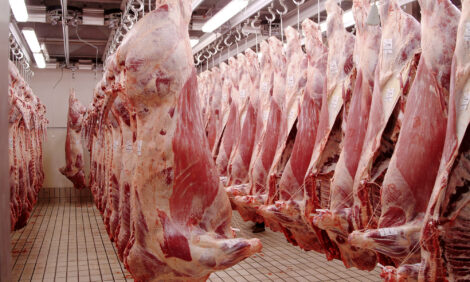



How the US pork industry is preparing for a possible FAD outbreak
There are three FADs that would have a major impact on limiting US exports of pork: foot-and-mouth disease (FMD), ASF and classical swine fever (CSF).Second in a series; read Part 1 here.
The amount of travel to and from the US, coupled with the large volume of international commerce and the fact that some FAD viruses can survive trans-oceanic crossings in some feed ingredients, on clothing and in pork food products, markedly increase the probability of exposure.
‘It is inevitable’
“I do think it is inevitable that we will have an outbreak of a trade-limiting FAD,” said Jim Roth, DVM, PhD, director of the Center for Food Security and Public Health (CFSPH), Iowa State University. “Whether it will happen soon or in a few years, I don’t know.”
Paul Sundberg, DVM, executive director of the Swine Health Information Center (SHIC), agrees with that prediction. “I would say one of the things that is very important with all of these diseases is to assume when rather than if they will reach the US. Plan for the worst and hope for the best.”
Valuable lessons
The good news is that the US pork industry, veterinarians, federal and state regulatory agencies and academics have not sat idle as ASF wreaks havoc on the swine industry in parts of the EU and China.
The valuable lessons learned from the porcine epidemic diarrhoea (PED) virus outbreak in 2013 – a surprise attack that, according to the National Pork Producers Council (NPPC), claimed 7 million pigs within a 12-month period - have put the US pork industry in a much better position to respond to an FAD outbreak.
“I don’t know that with something as impactful as an FAD we can say we are prepared, but I do know that we are more prepared than we have ever been,” said Pamela Zaabel, DVM, of CFSPH.
How is the pork industry preparing?
1. Updated Secure Pork Supply Plan
Containing an FAD outbreak is one challenge; maintaining business continuity is another. To this end, the industry and the USDA have teamed up to develop a Secure Pork Supply (SPS) Plan, which aims to keep pigs flowing from unaffected farms. The plan is funded by USDA and the Pork Checkoff – a programme of the National Pork Board (NPB) – and the website is run by Iowa State University and the University of Minnesota.
The goal of this voluntary programme is to enhance communication among all pork-chain segments, accurately identify affected farms and keep pigs flowing from farms that are within an FAD-control area but are not infected with the disease. US pork producers are encouraged to enrol and obtain a national, standardised premises identification number for each production site separated by more than a quarter of a mile.
Enrolment gives producers the opportunity to demonstrate to state animal-health officials that certain measures such as traceability, biosecurity protocols, records and negative diagnostic results are in place. That, in turn, will allow officials to quickly evaluate the status of each farm and ultimately make it possible for producers to move unaffected pigs more efficiently.
In recent months, the plan has been updated and the website revamped. It is even more user friendly and laid out to quickly direct various groups – including producers, veterinarians, packers and regulatory officials - to web pages specifically designed for them.
Producers are encouraged to start implementing the programme details, to get trained in biosecurity and write up biosecurity plans for their sites.
“You don’t want to try to figure things out during an outbreak,” Patrick Webb, DVM, director of swine-health programmes for NPB, told Pig Health Today. “While SPS focuses on FADs, it is building an infrastructure that could be used to address other new, emerging diseases if needed.”
Packers are also a key part of this plan. The plan encourages them to work closely with state animal-health officials to determine the best options that reduce FMD, CSF or ASF virus spread via livestock trucks and plant employees, while aligning with capabilities and local regulations.
2. Better diagnostics network and reporting
In collaboration with NPB and NPPC, SHIC has developed a high-priority list of endemic and foreign swine pathogens known as the Swine Disease Matrix.
The matrix, which includes an assessment of the diagnostic capabilities for selected pathogens, is a living document. In addition to ASF, CSF and FMD, the matrix includes several other diseases such as influenza A virus, PED virus, pseudorabies and porcine reproductive and respiratory syndrome. It is regularly reviewed by a SHIC working group for content and priority. The matrix is prioritised based on the average 1-10 score of each pathogen using the following three criteria:
- The likelihood of foreign pathogens entering the US.
- The expected production and economic impact of disease from pathogens.
- The probable effect on domestic and international markets from an outbreak due to the listed pathogens.
USDA is working with the pork industry to develop and host an ASF exercise in 2019 to test key response functions necessary for successful ASF management and containment. Participants will include pork producers and swine veterinarians.
“The value is in being able to help producers understand the risks that might be coming at them,” Sundberg told Pig Health Today. “If you know what’s going on around you, you have the ability to prevent it, which is the goal, or at least be better prepared to respond.”
3. Improved surveillance efforts
To further advance preparedness, USDA’s Animal and Plant Health Inspection Service has approved 11 National Animal Health Laboratory Network laboratories around the country to test for ASF. Another 22 laboratories have been identified. These numbers are moving targets. The current laboratory capacity is 6,500 polymerase chain reactions (PCR) per day, and officials are exploring the possibility of increasing the daily capacity to 9,000.
In addition, SHIC has released the Polymerase Chain Reaction Assay Catalog, which outlines 17 newly developed PCR tests for specific pathogens as well a list of experts to contact for questions and guidance. The catalogue summarises the research behind the development of each of the PCR tests and provides technical information regarding sample collection as well as analytical and diagnostic sensitivity and specificity. Although the audience is primarily diagnosticians, the reach is much broader.
“The direct value to practising veterinarians is in the knowledge that the veterinary diagnostic labs have the capability to use these tests,” Sundberg told Pig Health Today. “This will be most helpful if they hit a diagnostic dead end or suspect something other than the usual etiology.”
The swine industry currently lacks a standardised system for distributing producer data across states. So the NPB is funding AgView, a database and dashboard system that will make it possible for participating producers to rapidly share data with animal-health officials.
4. Talking with feed suppliers
In the wake of the discovery and spread of ASF in China, where all or most vitamins and some other key feed ingredients are manufactured, feed safety has become a top priority for pork producers and feed suppliers.
For this reason, SHIC, NPB, NPPC and the American Association of Swine Veterinarians (AASV) have prioritised research to determine the proper holding time for feed ingredients or finished-feed products made in China. SHIC is funding a comprehensive investigation into the half-life of viruses (the amount of time it takes for 50 percent of the virus to naturally degrade) in feed ingredients.
For example, research shows that a holding time of 78 days after the date of manufacture, bagging or sealing will degrade 99.99 percent of viral contamination. The holding time is 286 days for bulk/unsealed ingredients such as soybean meal to allow for similar viral degradation, once shipped, to prevent additional contamination.
“Working with your feed supplier to get this type of information is yet another way to help protect your pigs from potential infection from an FAD,” Dave Pyburn, DVM, NPB’s senior vice president of science and technology, told Pig Health Today. “It’s just one more tool in our arsenal against ASF and other diseases.”
5. Veterinarians on the front lines
The AASV is striving to raise FAD awareness among its members. It has worked closely with producer organisations and the USDA to develop educational materials describing the diseases and outlining response procedures, Harry Snelson, DVM, AASV director of communications, told Pig Health Today. It has compiled a packet of resources about FADs in general and ASF in particular that it plans to mail to members, Snelson said.
“We are actively involved with state and federal animal-health officials and swine-industry folks to design and participate in ASF-specific exercises to evaluate response plans,” he said, adding that AASV is reminding veterinarians that FADs should be on their differential lists when exploring disease outbreaks and submitting samples to the diagnostic labs.
“Vets and producers will be the first to see a new-disease introduction, and the quicker they can recognise that something is not right the better chance we have to stop the spread,” he said.






